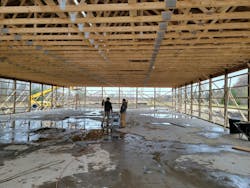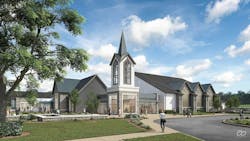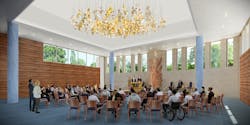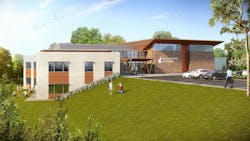Places of worship, searching for relevance, upgrade and expand their buildings and reach
By John Caulfield, Senior Editor
A recent Gallup poll found that, for the first time in eight decades of surveying, the portion of U.S. adults belonging to a church, synagogue, or mosque fell below 50 percent in 2020. Membership, in fact, had been falling since the 1980s. And at under $3 billion in annual construction value, according to Census Bureau estimates, the Religious sector is often an afterthought in discussions about nonresidential building spending and trends.
Nevertheless, several projects that have come onto the scene recently illustrate how places of worship still strive to play vital community roles.
•In October, Cheboygan (Wis.) Compassionate Ministries and Cheboygan Church of the Nazarene broke ground on a 6,000-sf facility that will house a new church, a 1,200-sf soup kitchen, classrooms, two bathrooms, and a laundry. Fifteen years in the making, this center, which is scheduled to open next summer, sits on eight acres. A local architect, Richard Clements, is the designer, and Livonia, Mich.-based George Pastor & Sons General Contractors is the GC on this $500,000 project, which the Ministry and Church are paying for through fundraising. Ryan Pastor, the estimator and project manager, says the facility is being completed in three phases: currently, his firm is building the enclosure, after which church volunteers will step in during the winter months to install drywall, insulation, bathroom fixtures, and so forth. In late spring, the GC will return to install the building’s mechanicals and lay its parking lot.
•In Pennsylvania, sitework was scheduled to start on November 22 for Grace Church Bethlehem’s $22 million, 35,000-sf worship facility that will feature a 650-seat Sanctuary equipped for both in-person and online worship, an atrium, café and multipurpose room, children and student spaces, administrative spaces, and a memorial garden. Serfass Construction, which has built dozens of churches throughout the Lehigh Valley, is the CM on this ground-up project, which was designed by Doylestown, Pa.-based Mann-Hughes Architects. This is the first church to be built in Bethlehem in over a decade. It should be completed by the first quarter of 2023.
•The National Presbyterian Church, as a congregation, dates back to 1795, and its Modern Gothic National Presbyterian Church in Washington, D.C., was built in 1967. A project team led by Beyer Blinder Belle last month completed renovating 24,062 sf of the Main Church and expanding it by 6,627 sf with two additions. (BBB was selected as the architect for this alteration after the firm completed the church’s 2016 Master Plan.) The additions improve accessibility and provide new community spaces that introduce a new rear entry and two new elevators. The second, limestone-clad addition includes new classroom, meeting and outdoor gathering spaces with a terrace and gardens. A central stair now connects all three levels of the church, and addresses accessibility, traffic flow, and programming unification. The renovation also introduces flexible gathering spaces. The design rectifies deferred maintenance via terrace waterproofing, HVAC and boiler replace, security improvements, lighting, and technology infrastructure. New sustainable features include stormwater retention, new energy efficient mechanicals and lighting. The building and reno team included 120 Architectural Engineers (SE), James Posey Associates (MEP/FP), Wiles Mensch Corporation (CE), MCN Build (CM), Stroik Lighting Design (lighting), Jensen Hughes (Code/Life Safety), Michael Vergason Landscape Architects (LA), Miller, Beam and Paganelli (AV/Acoustics/IT), and Vertran Enterprises (vertical transportation).
•Princeton, N.J.-based architecture and design firm Landau Zinder has three projects scheduled for completion by next January or February: Construction of Yakov & Hava Telyas Chabad Jewish Center, a new 15,000-sf synagogue and learning center on 10 acres in Clinton, N.J.; and renovations of Scarsdale (N.Y.) Synagogue Temples Tremont and Emanu-el and Sinai Temple, a synagogue in Champaign, Ill. For the Champaign and Scarsdale projects, Landau Zinder also consulted on venue security and helped it clients apply for grants from the Department of Homeland Security. At Sinai Temple, the renovation created flexible sanctuary space, with a primary “pod” that accommodates smaller gatherings for weekly services., and movable walls that allow the sanctuary to more than triple its capacity to 500 people. The temple’s suspended ceiling was designed to symbolize the two tablets of the Ten Commandments, and new window openings let in more light. The Scarsdale renovation included demolishing the entire south-facing wall to transform the sanctuary, and redesigning the building’s interior to present a more “timeless” look. The Yakov & Hava Telyas Chabad Jewish Center includes classrooms for pre-K, Hebrew school, and adult ed, as well as a sanctuary, meeting rooms, offices, a kosher kitchen, youth lounge, and library/media room. The site offers an outdoor learning space, playground, and parking for 70 cars. The building team for the New Jersey project include Integrated Green Technologies (GC) and Jarmel Kizel Architects & Engineers (SE, MEP). The team for the Scarsdale project include Cow Bay Contracting (GC), Desimone Consulting Engineers (SE), and Loring Consulting Engineers (MEP). The team for the Illinois project include Felmley-Dickerson (GC), C.E. Anderson & Associates (SE) and Henneman Engineering (MEP).






